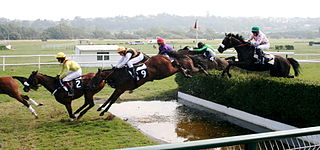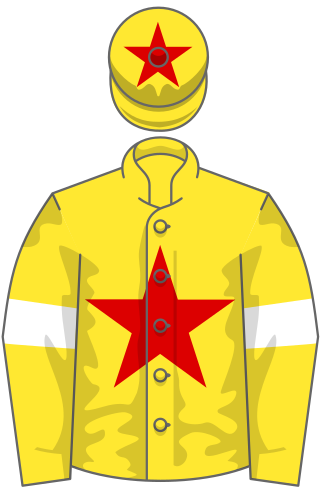
The Grand National is a National Hunt horse race held annually at Aintree Racecourse, Aintree, Merseyside, England. First run in 1839, it is a handicap steeplechase over an official distance of about 4 miles and 2½ furlongs, with horses jumping 30 fences over two laps. It is the most valuable jump race in Europe, with a prize fund of £1 million in 2017. An event that is prominent in British culture, the race is popular amongst many people who do not normally watch or bet on horse racing at other times of the year.
In horse racing in the United Kingdom, France and Republic of Ireland, National Hunt racing requires horses to jump fences and ditches. National Hunt racing in the UK is informally known as "jumps" and is divided into two major distinct branches: hurdles and steeplechases. Alongside these there are "bumpers", which are National Hunt flat races. In a hurdles race, the horses jump over obstacles called hurdles; in a steeplechase the horses jump over a variety of obstacles that can include plain fences, water jump or an open ditch. In the UK, the biggest National Hunt events of the year are generally considered to be the Grand National and the Cheltenham Gold Cup.

Aintree Racecourse is a racecourse in Aintree, Metropolitan Borough of Sefton, Merseyside, England, bordering the city of Liverpool. The racecourse is the venue for the Grand National steeplechase, which takes place annually in April over three days. Aintree also holds meetings in May and June, October (Sunday), November and December.

Cheltenham Racecourse at Prestbury Park, near Cheltenham, Gloucestershire, England, hosts National Hunt horse racing. Racing at Cheltenham took place in 1815, but comprised only minor flat races on Nottingham Hill. The first racing on Cleeve Hill was on Tuesday 25 August 1818 when the opening race was won by Miss Tidmarsh, owned by Mr E Jones. It was a year later when the results were printed in the Racing Calendar when a programme of flat racing was watched by the Duke of Gloucester who donated 100 Guineas to the prize fund. By 1831 races were being staged at Prestbury, although not on the present day course. In 1834 the Grand Annual Steeplechase was run for the first time. In 1839 Lottery won the Grand Annual having previously won the first Aintree Grand National. In 1840 the meeting transferred to Andoversford for a brief period, only to return to Prestbury in 1847. 1902 was a notable year in that racing moved to the present course at Prestbury Park. The new stands were completed in 1914 and the present day Festival races, as we know them, began to take shape. The Cheltenham Gold Cup, over 3 ¼ miles, was run for the first time in 1924, with the Champion Hurdle following in 1927.
Racing TV is a British television channel with 34 racecourses as shareholders and fixtures from 61 racecourses broadcast live on its output. As Racing UK grew several other business units and joint ventures were developed under the ownership of the parent company Racecourse Media Group Ltd. Racing TV is one of the two major UK horse racing television channels, the other being Sky Sports Racing. The station is dedicated to horse racing broadcasting over 70% of all live racing from Britain and Ireland, including nearly 90% of all Group and Graded races.

A point-to-point is a form of horse racing over fences for hunting horses and amateur riders. In Ireland, where the sport is open to licensed professional trainers, many of the horses will appear in these races before they compete in National Hunt races. Consequently, the Irish point-to-point tends to be used as a nursery for future young stars: a horse that wins its debut point-to-point in Ireland will often sell for a high price. Whilst professional trainers are specifically excluded from running horses in point-to-points in Great Britain, the days of the farmer running his hunter at the local point-to-point are gone.. Increasingly, horses are run from "livery yards" - unlicensed but otherwise professional training establishments, sometimes closely allied with a licensed yard.

A steeplechase is a distance horse race in which competitors are required to jump diverse fence and ditch obstacles. Steeplechasing is primarily conducted in Ireland, the United Kingdom, Canada, United States, Australia, and France. The name is derived from early races in which orientation of the course was by reference to a church steeple, jumping fences and ditches and generally traversing the many intervening obstacles in the countryside.
The Melling Chase, currently known for sponsorship purposes as the Marsh Chase, is a Grade 1 National Hunt steeplechase in Great Britain which is open to horses aged five years or older. It is run at Aintree over a distance of about 2 miles and 4 furlongs, and during its running there are sixteen fences to be jumped. The race is scheduled to take place each year in early April.

Uttoxeter Racecourse is a National Hunt racecourse in Uttoxeter, Staffordshire, England.

The 2001 Grand National was the 154th official running of the Grand National horse race that took place at Aintree Racecourse near Liverpool, England, on 7 April 2001. It went ahead as planned, despite the cancellation of the 2001 Cheltenham Festival, caused by the foot-and-mouth disease crisis.

Aintree Motor Racing Circuit is a 3.000 mi (4.828 km) motor racing circuit in the village of Aintree, Metropolitan Borough of Sefton, Merseyside, England. The circuit is located within the Aintree Racecourse and used the same grandstands as horse racing. It was built in 1954 as the "Goodwood of the North", hence the fact the two venues had so many things in common. The track was well surfaced and relatively flat – ranging from 49–98 ft (15–30 m) in elevation.
The Mildmay Novices' Chase is a Grade One National Hunt chase in Great Britain which is open to horses aged five years or older. It is run on the Mildmay course at Aintree over a distance of about 3 miles and 1 furlong, and during its running there are nineteen fences to be jumped. The race is for novice chasers, and it is scheduled to take place each year during the Grand National meeting in early April.

The 1998 Grand National was the 151st official renewal of the world-famous Grand National steeplechase that took place at Aintree near Liverpool, England, on 4 April 1998.
The 1849 Grand National Steeplechase was the 11th official annual running of a handicap steeplechase horse race at Aintree Racecourse near Liverpool on Wednesday, 28 February. It attracted a field of twenty-four competitors for a prize valued at £825.

The 2012 Grand National was the 165th annual renewal of the Grand National horse race at Aintree Racecourse near Liverpool, England. The showpiece steeplechase, which concluded a three-day meeting which is one of only four held at Aintree throughout the year, took place on 14 April 2012. The maximum permitted field of 40 runners ran the last 4 miles 856 yards (7.220 km) of Aintree's National Course featuring 30 fences, competing for record prize money of £975,000, making it the highest-valued National Hunt race in the United Kingdom.
The 1851 Grand National was, at the time, the 14th renewal of a handicap steeplechase horse race that took place at Aintree near Liverpool, England, on 26 February 1851. However, this was later retrospectively recorded as the 13th official running by the Steeplechase Calendar of 1864 when the race of 1838 was disregarded as official.
Morley Street (1984-–2009) was an Irish racehorse. He was a specialist hurdler but also won steeplechases and races on the flat. In a racing career which lasted from November 1988 until December 1995, he ran forty-five times and won twenty races including the Champion Hurdle in 1991 and the Aintree Hurdle on four successive occasions. He won the title of American Champion Steeplechase Horse on two occasions, as a result of back-to-back wins in the Breeders' Cup Steeplechase.

Charter Party was an Irish-bred British-trained thoroughbred racehorse, best known for his win in the 1988 Cheltenham Gold Cup. He overcame persistent injury problems to win twelve races under National Hunt rules. He showed promise as a hurdler and as a Novice steeplechaser before recording his first major win in the 1986 National Hunt Handicap Chase. As a ten-year-old in 1988 he defeated Desert Orchid in the Gainsborough Chase, before taking the Gold Cup at Cheltenham in March. He never won again, but produced a fine effort to finish third on heavy ground in the 1989 Gold Cup.
Mirabel Topham was chairman and managing director of Topham Ltd for 36 years to 1973 and owner of Aintree Racecourse in Liverpool, England, where the Grand National horse steeplechase is held. She was one of the colourful and controversial personalities in UK racing during this time.

One For Arthur was an Irish-bred Thoroughbred racehorse who competed in National Hunt racing. In 2017 he became the second horse trained in Scotland to win the Grand National.












